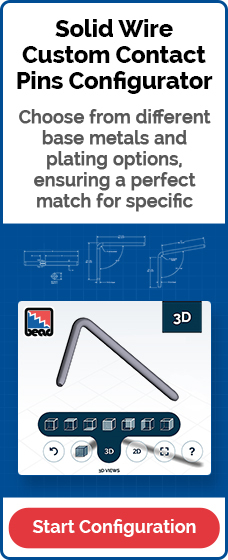In the world of manufacturing, standard doesn’t always cut it. Bead Electronics has been manufacturing custom contact pins and pin assemblies for over 100 years, creating tailored solutions to address mechanical, electrical, and environmental challenges.
When designing contact pins to mate with standard connectors, choosing the right pin base material and plating alloy can help improve durability and conductivity; however, the real key to connector performance lies in the housing. It’s the housing that provides alignment, stability, and protection—especially critical when working with small, delicate pins like those designed by Bead Electronics.
.jpg?width=3189&height=1903&name=PinRgtAngle12812Pins%20(1).jpg)
Here are the top 5 reasons contact pins fail in standard connector assemblies:
1. Mechanical Deformation During Insertion or Mating
If too much force is required to mate connectors, you risk damaging components, increasing wear, or complicating automated assembly. In worst-case scenarios, connectors can become unusable.
Mating force issues typically result from oversized contact pins, over-tight insertion fits, or lack of plating uniformity. Plating options like gold or tin can reduce friction and improve mating smoothness. In physically demanding applications, stronger base materials like Phos Bronze can help support performance. That said, you will also need housing that evenly distributes mechanical stress and keeps pins aligned.
2. Improper Plating or Surface Finish
Contact plating is essential for manufacturing electronic components. It improves performance, utility, and durability. Proper plating helps ensure a device will perform reliably, improves corrosion resistance, and maintains electrical conductivity. It also enhances solderability and protects the metal conductor from wear. For more information on plating options with custom contact pins, check out our Guide to Electrical Contact Plating here.
3. Thermal Expansion and Heat-Induced Stress
Overheating is often the result of high contact resistance, which can stem from misalignment, corrosion, or wear. Always measure resistance during quality testing and ensure your contact pins are designed to handle the electrical load of your application.
Beyond the pins themselves, it’s the housing that plays a vital role in managing thermal stress. If the housing material expands at a different rate than the pins during temperature fluctuations, it can put uneven pressure on the contact interfaces - leading to micro-gaps, compromised conductivity, or cracking.
4. Vibration and Shock in Harsh Environments
Swaged pins are designed for repeated mating cycles and better retention, ideal for pins that will be subjected to vibration, shock, or mechanical wear.
In environments where high-impact or sustained vibration is expected—such as industrial machinery, transportation, or aerospace—loose tolerances in the housing can allow pins to shift, fatigue, or disconnect.
5. Contamination or Foreign Particles
In humid, dusty, or chemically aggressive environments, unprotected pins can corrode or accumulate debris. Choosing the right finish, such as gold or nickel plating, can extend lifespan and maintain conductivity.
By selecting materials with higher tensile strength or different pin finishes, Bead Electronics designs custom contact pins to mate with standard connectors in even the toughest environments.
In addition to custom contact pins, Bead Electronics also offers custom pin assemblies. Because the housing provides the alignment, as well as seals and protects the pins from damage, a custom pin assembly can have an even greater impact on performance.
Why Housing Matters
While contact pin materials, finishes, and plating get most of the attention, the housing is just as critical to the long-term reliability of your connector system.
The housing is not just a container—it’s the backbone of your connector system. It’s responsible for aligning the pins, maintaining the seal against environmental intrusions, and absorbing stress from mating, vibration, and temperature fluctuations.
In fact, for pins the size of those made by Bead Electronics, housing quality is the single most important factor in connector reliability. While materials and plating affect performance, they can only do so much. Without proper housing, even the best-designed contact pins are at risk of deformation, misalignment, and failure.
Unlock New Levels of Performance with Bead
At Bead Electronics, we bring over a century of precision engineering to every project—not only designing the pins, but ensuring they function flawlessly within your connector’s ecosystem. Our custom connector pin assemblies are high-quality and customizable, with various shapes, sizes, and features to fit all of your specific requirements. We offer a wide range of materials and finishes, ensuring that you get a product that holds up under any conditions.
Contact us today to learn more about our custom contact pins and pin assemblies!



